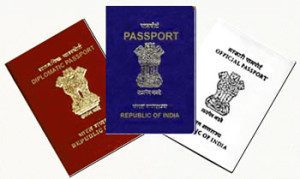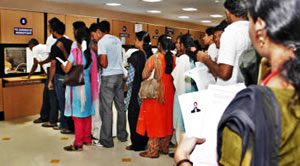When it comes to getting or renewing your passport, India, like any other country, has its specific formalities that need to be fulfilled.
According to the “Passports Act” from 1967, the Indian passport was established as the primary document providing the right to international travel and proof of Indian citizenship while abroad, for all Indian citizens.
 There are three types of passports available: the regular one (with its characteristic deep blue cover and 36 or 60 pages), available to all regular citizens for any ordinary travel (vacations, business trips, etc.), the diplomatic passport (with maroon cover), available only to diplomatic personnel and top government officials, and the official passport (white cover), issued to those representing the government on official business.
There are three types of passports available: the regular one (with its characteristic deep blue cover and 36 or 60 pages), available to all regular citizens for any ordinary travel (vacations, business trips, etc.), the diplomatic passport (with maroon cover), available only to diplomatic personnel and top government officials, and the official passport (white cover), issued to those representing the government on official business.
There is another type of passport India authorities issue only to citizens residing in certain states and territories (West Bengal, Assam and the other North Eastern States, Tamil Nadu and Puducherry): the Indo-Bangladesh passports and Indo-Sri Lankan passports that allow Indian nationals in those areas to travel to Bangladesh and, respectively, Sri Lanka.
The institution responsible with issuing and renewing Indian passports is the (CPV) division of the Ministry of External Affairs. CPV operates through Regional Passport Offices (RPO) in India (currently, there are 37 RPOs distributed across the country). For citizens abroad requesting a new passport, India’s diplomatic missions in other countries are responsible (currently 162).
Starting from 2007, the Government of India launched a new system, centralizing front-end activities, like passport printing, issuance and dispatch, and online linking with the police – the Passport Seva Project.
The objective was to make the process easier for applicants, faster and more transparent. Under this system, passport issuing was directed to 77 local offices throughout the country, the Passport Seva Kendras (PSK) and the District Passport Cells (DPC).
Nowadays, RPO take only certain special cases, regular applicants being directed to the local PSK and DPC. Keep in mind that any RPO, PSK or DPC will accept applications only from citizens residing within their jurisdiction at the time of application.
How to Apply for an Indian Passport?
First, you should know that, for getting a passport, India allows two possible procedures: applying in person or submitting your documents and forms through e-mail, the so-called Tatkal system.
Apart from the forms you need to fill, there are a few documents needed for the application. First, you must have a document proving your date of birth, usually a birth certificate, but, in special cases, a school or secondary school leaving certificate or an affidavit, sworn before a magistrate or notary, stating the date and place of your birth (for illiterate applicants) will do.
Second, in order to get a passport, India’s citizens need a proof of their current address: a utility bill, certificate from the employer, passport copy of the spouse or parents (for minors) etc.
If you use the Tatkal system to apply online for passport, you also need three of the following documents:
- Electors Photo Identity Card;
- Service Photo Identity Card released by State/Union Government;
- Certificate for SC/ST/OBC;
- Identity Card of Freedom Fighter;
- Arms License;
- Property documents;
- Pension documents (Pension Book/Pension Payment order, Widow/Dependent Certificates, Widow Pension Order);
- Railway Identity Cards;
- Rations cards;
- Birth certificate;
- Student Photo Identity Cards;
- Driving Licenses;
- Bank/Kisan/Post Office Passbooks;
- Income Tax Identity (PAN) Card;
- Gas connection bill;
- Aadhar Card issued by the UIDAI.
While most of these documents are required in any country of the world to get a passport, India’s issues regarding border conflicts and pre-independence-related problems cause some special considerations.
 Some categories, like the residents of Jammu and Kashmir and Nagaland, family members of serving or retired Government and PSU employees or students not residing in their home area need certain additional documents for passport application. Checking the official CPV website or asking the local PSK or DPC officials for information should clarify these additional requirements.
Some categories, like the residents of Jammu and Kashmir and Nagaland, family members of serving or retired Government and PSU employees or students not residing in their home area need certain additional documents for passport application. Checking the official CPV website or asking the local PSK or DPC officials for information should clarify these additional requirements.
Tatkal users have to fill the e-form according to the rules stated on the website and schedule an appointment at the local PSK. They will receive an application receipt (with an appointment number included) that they must print and show at the PSK.
The platform allows them to track the status of their application in real time. As a piece of advice, it is important not to miss the scheduled appointment and have suitable photographs taken.
How to Renew an Indian Passport?
Obviously, it is much easier to renew your passport, India’s Tatkal system making it really fast. Apart from the e-form you must fill, you also need the following documents:
- A copy of your passport’s first page, last page and of the page with the ECNR info and, also, your signature;
- A proof of the current address (a utility bill, for instance);
- If you wish to add your spouse’s name, you also need a copy of your marriage certificate.
If your address changed, you also need a proof of this change, for passport renewal.
To sum up, when it comes to getting or renewing your passport, India’s new regulations make the process a lot faster and easier, using the numerous local PSK and DPC and the online platform.
Awesum
Satisfied
this was very use to me,thankyou for your information
simply superb it was very useful to me thank u very much